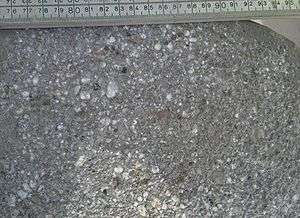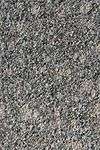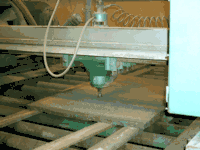Bush hammer
A bush hammer is a masonry tool used to texturize stone and concrete. Bush hammers exist in many forms, from simple hand-held hammers to large electric machines, but the basic functional property of the tool is always the same – a grid of conical or pyramidal points at the end of a large metal slug. The repeated impact of these points into stone or concrete creates a rough, pockmarked texture that resembles naturally weathered rock. They can help to increase bonding effectiveness when applying new concrete to an existing concrete surface by increasing the surface area of the bonding zone.
A bush hammer

A bush-hammered concrete surface
Gallery
- A bush hammer chisel for pneumatic hammers
- Bush-hammered sandstone
 Bush-hammered granite porphyry
Bush-hammered granite porphyry Bush-hammering machine
Bush-hammering machine
gollark: Haskell meets 1 (obviously), 2, 3, kind of 5 and maaaybe 7.
gollark: - nice, nonbrackety haskell syntax- functional-programming-oriented- strongly typed- pragmatic and not horribly complicated - yes, selective applicative functors or whatever new haskell thing is now being worked on may be elegant, but learning every needlessly fancy thing just takes away from *actually writing useful stuff*- good tooling (see: Rust; run screaming from: Go, C(++))- web platform, ideally (yes, it has Problems™, but there's something to be said for ability to just navigate to a webpage and run your stuff- good libraries/community
gollark: I'll probably never find a language which satisfies all my wants:
gollark: <:ninja:445055784057962497>
gollark: What is this?
See also
- Henri Bouchard – French sculptor
- Scabbling – A process to remove a thin layer of stone or concrete by rapid impacts with a small hard tool tip
- Stone flaming – The application of high temperature to the surface of stone to make it look like natural weathering
References
This article is issued from Wikipedia. The text is licensed under Creative Commons - Attribution - Sharealike. Additional terms may apply for the media files.